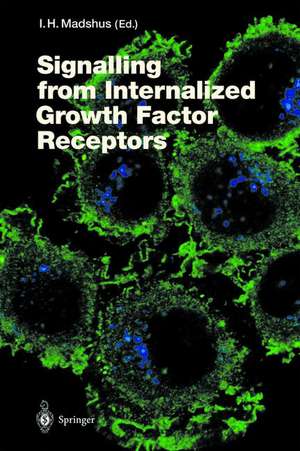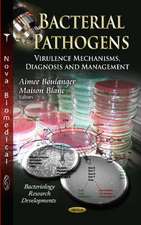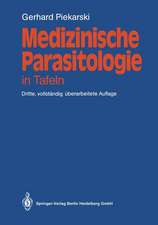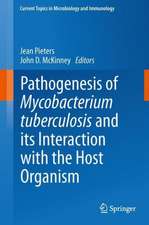Signalling from Internalised Growth Factor Receptors: Current Topics in Microbiology and Immunology, cartea 286
Editat de Inger Helene Madshusen Limba Engleză Hardback – 9 iul 2004
| Toate formatele și edițiile | Preț | Express |
|---|---|---|
| Paperback (1) | 971.85 lei 38-44 zile | |
| Springer Berlin, Heidelberg – 3 mar 2011 | 971.85 lei 38-44 zile | |
| Hardback (1) | 1093.35 lei 6-8 săpt. | |
| Springer Berlin, Heidelberg – 9 iul 2004 | 1093.35 lei 6-8 săpt. |
Din seria Current Topics in Microbiology and Immunology
- 18%
 Preț: 962.03 lei
Preț: 962.03 lei - 5%
 Preț: 1123.13 lei
Preț: 1123.13 lei - 5%
 Preț: 1085.95 lei
Preț: 1085.95 lei -
 Preț: 499.77 lei
Preț: 499.77 lei - 5%
 Preț: 967.81 lei
Preț: 967.81 lei - 18%
 Preț: 1118.62 lei
Preț: 1118.62 lei - 5%
 Preț: 717.00 lei
Preț: 717.00 lei - 5%
 Preț: 712.97 lei
Preț: 712.97 lei - 5%
 Preț: 709.51 lei
Preț: 709.51 lei - 5%
 Preț: 709.51 lei
Preț: 709.51 lei - 5%
 Preț: 721.19 lei
Preț: 721.19 lei - 5%
 Preț: 359.78 lei
Preț: 359.78 lei - 5%
 Preț: 711.88 lei
Preț: 711.88 lei - 5%
 Preț: 774.81 lei
Preț: 774.81 lei - 15%
 Preț: 640.06 lei
Preț: 640.06 lei - 5%
 Preț: 717.00 lei
Preț: 717.00 lei - 5%
 Preț: 360.34 lei
Preț: 360.34 lei - 5%
 Preț: 707.69 lei
Preț: 707.69 lei - 5%
 Preț: 717.56 lei
Preț: 717.56 lei - 5%
 Preț: 716.28 lei
Preț: 716.28 lei - 5%
 Preț: 717.20 lei
Preț: 717.20 lei - 5%
 Preț: 711.32 lei
Preț: 711.32 lei - 5%
 Preț: 711.88 lei
Preț: 711.88 lei - 5%
 Preț: 718.29 lei
Preț: 718.29 lei - 5%
 Preț: 709.51 lei
Preț: 709.51 lei - 5%
 Preț: 369.84 lei
Preț: 369.84 lei - 5%
 Preț: 712.25 lei
Preț: 712.25 lei - 5%
 Preț: 716.45 lei
Preț: 716.45 lei - 5%
 Preț: 706.60 lei
Preț: 706.60 lei - 5%
 Preț: 711.52 lei
Preț: 711.52 lei - 5%
 Preț: 713.54 lei
Preț: 713.54 lei - 5%
 Preț: 720.47 lei
Preț: 720.47 lei - 5%
 Preț: 725.42 lei
Preț: 725.42 lei - 5%
 Preț: 708.06 lei
Preț: 708.06 lei - 5%
 Preț: 713.70 lei
Preț: 713.70 lei - 5%
 Preț: 705.83 lei
Preț: 705.83 lei - 5%
 Preț: 710.96 lei
Preț: 710.96 lei - 5%
 Preț: 723.93 lei
Preț: 723.93 lei - 5%
 Preț: 707.69 lei
Preț: 707.69 lei - 5%
 Preț: 715.35 lei
Preț: 715.35 lei - 5%
 Preț: 709.87 lei
Preț: 709.87 lei - 5%
 Preț: 359.05 lei
Preț: 359.05 lei - 5%
 Preț: 374.20 lei
Preț: 374.20 lei - 15%
 Preț: 635.31 lei
Preț: 635.31 lei - 5%
 Preț: 707.86 lei
Preț: 707.86 lei - 5%
 Preț: 721.96 lei
Preț: 721.96 lei - 15%
 Preț: 632.88 lei
Preț: 632.88 lei - 15%
 Preț: 632.05 lei
Preț: 632.05 lei - 15%
 Preț: 642.83 lei
Preț: 642.83 lei
Preț: 1093.35 lei
Preț vechi: 1150.89 lei
-5% Nou
Puncte Express: 1640
Preț estimativ în valută:
209.24€ • 227.20$ • 175.76£
209.24€ • 227.20$ • 175.76£
Carte tipărită la comandă
Livrare economică 22 aprilie-06 mai
Preluare comenzi: 021 569.72.76
Specificații
ISBN-13: 9783540210382
ISBN-10: 3540210385
Pagini: 204
Ilustrații: IX, 190 p. 31 illus., 4 illus. in color.
Dimensiuni: 155 x 235 x 18 mm
Greutate: 0.4 kg
Ediția:2004
Editura: Springer Berlin, Heidelberg
Colecția Springer
Seria Current Topics in Microbiology and Immunology
Locul publicării:Berlin, Heidelberg, Germany
ISBN-10: 3540210385
Pagini: 204
Ilustrații: IX, 190 p. 31 illus., 4 illus. in color.
Dimensiuni: 155 x 235 x 18 mm
Greutate: 0.4 kg
Ediția:2004
Editura: Springer Berlin, Heidelberg
Colecția Springer
Seria Current Topics in Microbiology and Immunology
Locul publicării:Berlin, Heidelberg, Germany
Public țintă
ResearchCuprins
List of Contents.- Receptor Tyrosine Kinase Signaling and Trafficking—Paradigms Revisited.- Met Receptor Dynamics and Signalling.- Signaling, Internalization, and Intracellular Activity of Fibroblast Growth Factor.- Ubiquitin System-Dependent Regulation of Growth Hormone Receptor Signal Transduction.- Clathrin-Independent Endocytosis and Signalling of Interleukin 2 Receptors IL-2R Endocytosis and Signalling.- Signaling Through Monoubiquitination.
Textul de pe ultima copertă
This book reviews knowledge on the interconnection of signal transduction and endocytosis/intracellular trafficking. The chapters cover knowledge obtained by using different model systems. The first chapter deals with Receptor Tyrosin Kinases (RTKs) with emphasis on the Epidermal Growth Factor Receptor (EGF receptor) and the Platelet Derived Growth Factor Receptor (PDGF receptor). The second chapter deals with the RTK c-Met and with how this RTK becomes carcinogenic. The third chapter reviews recent understanding on the mechanisms of action of the numerous fibroblast growth factors and their receptors. In the fourth chapter we learn about the trafficking of and signalling from the Growth Hormone Receptor and how this receptor is controlled by ubiquitination. The fifth chapter is devoted to the Interleukin II receptor, essential for activation of T cells. Links between ubiquitination, signalling, endocytosis, and sorting are reviewed. The last chapter discusses current views on how monoubiquitination controls both signalling and trafficking and thereby the final outcome of receptor activation.
















